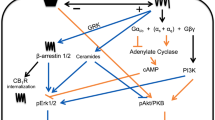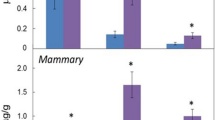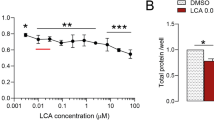Abstract
Lipid metabolism has been considered recently as a novel target for cancer therapy. In this field, lithium gamma-linolenate (LiGLA) is a promising experimental compound for use in the treatment of human tumours. In vivo and in vitro studies allowed us to assess the metabolism of radiolabelled LiGLA by tumour tissue and different organs of the host. In vitro studies demonstrated that human pancreatic (AsPC-1), prostatic (PC-3) and mammary carcinoma (ZR-75-1) cells were capable of elongating GLA from LiGLA to dihomo-gamma-linolenic acid (DGLA) and further desaturating it to arachidonic acid (AA). AsPC-1 cells showed the lowest delta5-desaturase activity on DGLA. In the in vivo studies, nude mice bearing the human carcinomas were given Li[1-(14)C]GLA (2.5 mg kg(-1)) by intravenous injection for 30 min. Mice were either sacrificed after infusion or left for up to 96 h recovery before sacrifice. In general, the organs showed a maximum uptake of radioactivity 30 min after the infusion started (t = 0). Thereafter, in major organs the percentage of injected radioactivity per g of tissue declined below 1% 96 h after infusion. In kidney, brain, testes/ovaries and all three tumour tissues, labelling remained constant throughout the experiment. The ratio of radioactivity in liver to tumour tissues ranged between 16- and 24-fold at t = 0 and between 3.1- and 3.7-fold at 96 h. All tissues showed a progressive increase in the proportion of radioactivity associated with AA with a concomitant decrease in radiolabelled GLA as the time after infusion increased. DGLA declined rapidly in liver and plasma, but at a much slower rate in brain and malignant tissue. Seventy-two hours after the infusion, GLA was only detected in plasma and tumour tissue. The sum of GLA + DGLA varied among tumour tissues, but it remained 2-4 times higher than in liver and plasma. In brain, DGLA is the major contributor to the sum of these fatty acids. Data showed that cytotoxic GLA and DGLA, the latter provided either by the host or by endogenous synthesis, remained in human tumours for at least 4 days.
This is a preview of subscription content, access via your institution
Access options
Subscribe to this journal
Receive 24 print issues and online access
$259.00 per year
only $10.79 per issue
Buy this article
- Purchase on Springer Link
- Instant access to full article PDF
Prices may be subject to local taxes which are calculated during checkout
Similar content being viewed by others
Author information
Authors and Affiliations
Rights and permissions
About this article
Cite this article
de Antueno, R., Elliot, M., Ells, G. et al. In vivo and in vitro biotransformation of the lithium salt of gamma-linolenic acid by three human carcinomas. Br J Cancer 75, 1812–1818 (1997). https://doi.org/10.1038/bjc.1997.309
Issue Date:
DOI: https://doi.org/10.1038/bjc.1997.309
This article is cited by
-
Multiple roles of dihomo-γ-linolenic acid against proliferation diseases
Lipids in Health and Disease (2012)
-
Clinical application of C18 and C20 chain length polyunsaturated fatty acids and their biotechnological production in plants
Journal of the American Oil Chemists' Society (2006)



